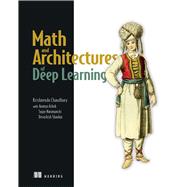Math and Architectures of Deep Learning
, by Krishnendu Chaudhury- ISBN: 9781617296482 | 1617296481
- Cover: Nonspecific Binding
- Copyright: 5/21/2024
Math and Architectures of Deep Learning sets out the foundations of DL usefully and accessibly to working practitioners.
The mathematical paradigms that underlie deep learning typically start out as hard-to-read academic papers, often leaving engineers in the dark about how their models actually function. Math and Architectures of Deep Learning bridges the gap between theory and practice, laying out the math of deep learning side by side with practical implementations in Python and PyTorch. You’ll peer inside the “black box” to understand how your code is working, and learn to comprehend cutting-edge research you can turn into practical applications.
Purchase of the print book includes a free eBook in PDF, Kindle, and ePub formats from Manning Publications.
About the technology
It’s important to understand how your deep learning models work, both so that you can maintain them efficiently and explain them to other stakeholders. Learning mathematical foundations and neural network architecture can be challenging, but the payoff is big. You’ll be free from blind reliance on prepackaged DL models and able to build, customize, and re-architect for your specific needs. And when things go wrong, you’ll be glad you can quickly identify and fix problems.
About the book
Math and Architectures of Deep Learning sets out the foundations of DL in a way that’s both useful and accessible to working practitioners. Each chapter explores a new fundamental DL concept or architectural pattern, explaining the underpinning mathematics and demonstrating how they work in practice with well-annotated Python code. You’ll start with a primer of basic algebra, calculus, and statistics, working your way up to state-of-the-art DL paradigms taken from the latest research. By the time you’re done, you’ll have a combined theoretical insight and practical skills to identify and implement DL architecture for almost any real-world challenge.
What's inside
About the reader
For Python programmers with algebra and calculus basics.
About the author
Krishnendu Chaudhury is a deep learning and computer vision expert with decade-long stints at both Google and Adobe Systems. He is presently CTO and co-founder of Drishti Technologies. He has a PhD in computer science from the University of Kentucky at Lexington.
The mathematical paradigms that underlie deep learning typically start out as hard-to-read academic papers, often leaving engineers in the dark about how their models actually function. Math and Architectures of Deep Learning bridges the gap between theory and practice, laying out the math of deep learning side by side with practical implementations in Python and PyTorch. You’ll peer inside the “black box” to understand how your code is working, and learn to comprehend cutting-edge research you can turn into practical applications.
Purchase of the print book includes a free eBook in PDF, Kindle, and ePub formats from Manning Publications.
About the technology
It’s important to understand how your deep learning models work, both so that you can maintain them efficiently and explain them to other stakeholders. Learning mathematical foundations and neural network architecture can be challenging, but the payoff is big. You’ll be free from blind reliance on prepackaged DL models and able to build, customize, and re-architect for your specific needs. And when things go wrong, you’ll be glad you can quickly identify and fix problems.
About the book
Math and Architectures of Deep Learning sets out the foundations of DL in a way that’s both useful and accessible to working practitioners. Each chapter explores a new fundamental DL concept or architectural pattern, explaining the underpinning mathematics and demonstrating how they work in practice with well-annotated Python code. You’ll start with a primer of basic algebra, calculus, and statistics, working your way up to state-of-the-art DL paradigms taken from the latest research. By the time you’re done, you’ll have a combined theoretical insight and practical skills to identify and implement DL architecture for almost any real-world challenge.
What's inside
- Math, theory, and programming principles side by side
- Linear algebra, vector calculus and multivariate statistics for deep learning
- The structure of neural networks
- Implementing deep learning architectures with Python and PyTorch
- Troubleshooting underperforming models
- Working code samples in downloadable Jupyter notebooks
About the reader
For Python programmers with algebra and calculus basics.
About the author
Krishnendu Chaudhury is a deep learning and computer vision expert with decade-long stints at both Google and Adobe Systems. He is presently CTO and co-founder of Drishti Technologies. He has a PhD in computer science from the University of Kentucky at Lexington.






